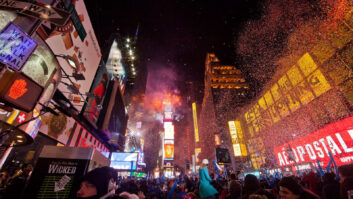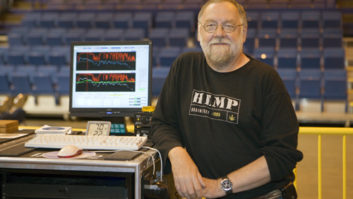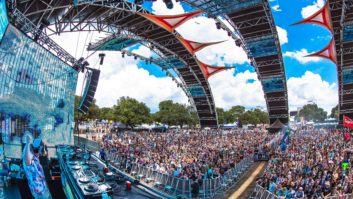New York, NY (May 21, 2014)—Conceived by Jack Viertel and directed by Warren Carlyle, one of the newest shows to grace the stage in New York City’s theater district is After Midnight, a musical experience that combines modern dance with the songs of Duke Ellington to bring theatergoers back to Harlem’s legendary Cotton Club. The show, presented at the Brooks Atkinson Theater in New York City, features the talents of The Jazz at Lincoln Center All-Stars, accompanied by a company of New York’s tops singers and dancers, with guest stars Vanessa Williams, Fantasia and Dule Hall.

For each show, the band is set up on a raised platform on the stage, versus in the orchestra pit below the stage, making the players as much a featured part of the show as the singers and dancers performing in front of the set up. Of course, this set up created numerous challenges for the show’s sound designer, Peter Hylenski, currently nominated for a Best Sound Design of a Musical Tony Award for the production. Hylenski needed to create a natural sound by balancing the live band with the singers’ voices without overpowering one or the other.
“Having the band on the stage and having a smaller performance area for the cast,” Hylenski said, “it’s less about the individual performers and more about the interactions and how everything melds together. The musicians are playing together in a very natural sense, and it makes our job easier because they are instinctually balancing their sections and ensemble.”
Hylenski, who has contributed to a number of Broadway shows and arena tours, said his sound design for this particular show is meant to compliment an organic feel using the latest technologies.
“It’s not so much about mixing a live show and manipulating the mix, but more about reinforcement and maintaining that natural feel that’s happening on stage, and just witnessing what’s happening,” he said.
For the band, each instrument has its own microphone hooked up to a Meyer Sound Q Console, manned by the show’s engineer, Kurt Fisher. “We set the band up like a recording session,” Hylenski explained. “Each instrument needs a little special attention. I use lots of ribbon mics, especially on the brass.”
When choosing a microphone for the instruments, Hylenski said his first priority is to maintain the quality of sound, and he picks mics on what makes the ensemble sound best. “It’s sort of a mixed bag chosen for the specific sounds we were going for,” Hylenski said. “I like to cater my mic choices towards what exactly we’re trying to do. The ribbon mics are all Royer products, but we use Sennheiser, Neumann, and a couple of Shures too.”
While the show is meant to recreate the atmosphere of The Cotton Club, Hylenski aimed to create that vintage atmosphere using modern technology. “I didn’t choose old-school mics; it was more about the modern telling of the story,” he said.
For the actors, Hylenski uses Sennheiser MKE-1s, with a Sennheiser SK52-12 transmitter. “One of the challenges with the show is that we’re still trying to keep normal theater standards, like hiding the mics in the actors’ hairline, whereas in a normal jazz performance, they’d use handheld mics to isolate the vocals,” said Hylenski.
Hiding the microphone in the hairline of the actors is a common practice in theater, especially in a show like After Midnight where the performers are constantly moving around the stage.
As might be expected, the actors wear well-hidden, wireless bodypacks for their microphones, whereas the band’s mics are wired. All of the microphones are run through a discrete Millennia mic preamp.
Hylenski’s custom sound design is built around a squadron of JBL Axys speakers (formerly Duran Audio products, Axys speakers have been rebranded following that company’s acquisition by Harman last year at AES). The considerable system includes a half-dozen JBL Axys Scope T-2115G2s; six Axys Scope T-2112G2s; a quartet of Axys Flex U-14s; and four Axys B-07 subs, all provided by PRG Audio. “It’s a fairly conventional system,” Hylenski explained, “but the loudspeakers sound fantastic. They have a great, warm, detailed sound.”
The sound designer said they don’t use any plug-ins for the show, but do have some outboard gear for vocals. “We use some Empirical Labs Distressors and TubeTech equipment,” he said. “This style of music is not a heavily processed type of music. It’s not so much about tightening the drums, for example, but about getting the mic positions correct. A lot of the compression we do use for the vocals is not about getting a pop sound, but to help us fit the vocals with the band.”
Throughout the show, that band plays the compositions of Duke Ellington, the dances combining classic jazz and tap with more modern dance techniques. “It’s a more modern retelling of what happened at The Cotton Club. Sound-wise, it’s certainly more HiFi than back then, just because they didn’t have the technology we do today,” said Hylenski. “After Midnight is unique—it has this purity to it, and with the band on stage each night, there’s a strong foundation. We’re able to build off of this incredible musical talent.”
After Midnight
aftermidnightbroadway.com
PRG Audio
prg.com






